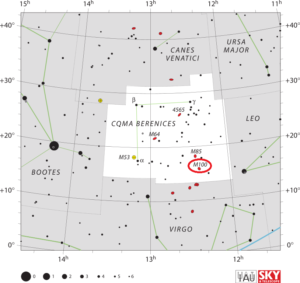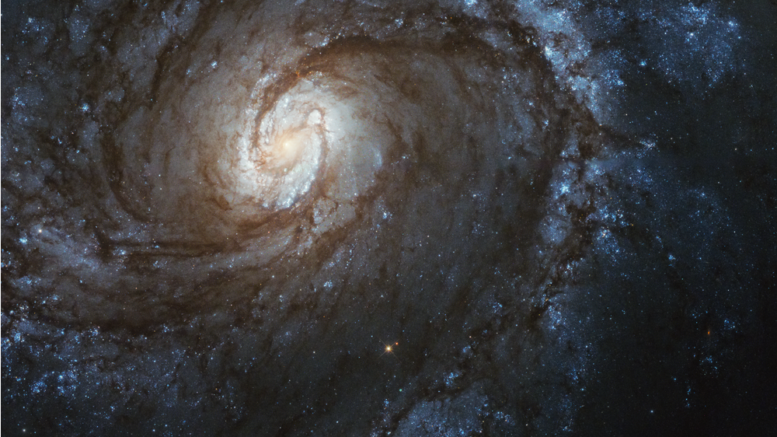Messier 100 is a starburst galaxy, with strongest bursts of star formation concentrated within a ring in the centre of the galaxy. The ring is in fact two tightly wound spiral arms connected to a small bar with a radius of 1 kiloparsec. Star formation has been taking place in this region for at least 500 million years in several bursts. The galaxy is estimated to contain about 400 billion stars.
Messier 100 is seen almost face-on. It has two prominent, well-defined spiral arms and several fainter ones. The arms are dotted with numerous star forming regions and clusters of young, hot, blue stars. The southern side of the galaxy contains more young stars, giving M100 a slightly asymmetric appearance. M100 is deficient in neutral hydrogen compared to similar galaxies that are isolated. As a result, M100 is not showing signs of star formation in the rest of the disk. The galaxy is experiencing ram pressure stripping as it moves through the Virgo Cluster and the process is leaving it without gas.
| Description | |
| Visible From Pacific Northwest | January to May |
| Best Time To Observe | February, March, and April |
| Minimum Size Of Viewing Device | Small Telescope Or Large Binoculars |
| Object Type | Spiral Galaxy |
| Designations | Messier 100, M100, NGC 4321, PGC 40153, ALFALFA 1-289, UGC 7450, VCC 596, 2E 2684, 2E 1220.3+1605, GB6 B1220+1605, HIPASS J1222+15, IRAS 12204+1605, 2MASX J12225489+1549205, MCG+03-32-015, NVSS B122022+160601, SDSS J122254.91+154920.2, UZC J122255.0+154922, Z 99-30, Z 1220.4+1606 |
| Right Ascension | 12h 22m 54.9s |
| Declination | +15°49’21” |
| Constellation | Coma Berenices |
| Number Of Stars | 400 Billion |
| Apparent magnitude | +10.1 |
| Apparent dimensions | 7′.4 x 6′.3 |
| Object Radius | 53,500 light years |
| Distance From Earth | 53,000,000 light years |
History
Messier 100 was discovered by Pierre Méchain on March 15, 1781, along with the nearby galaxies Messier 98 and Messier 99.
Charles Messier determined the position for the object and added it to his catalogue on April 13, 1781, just before he completed the third and final edition. Messier noted:
Nebula without star, of the same light as the preceding [Messier 99], situated in the ear of Virgo. Seen by M. Méchain on March 15, 1781. The three nebulae, nos. 98, 99 & 100, are very difficult to recognize, because of the faintness of their light: one can observe them only in good weather, & near their passage of the Meridian.
Charles Messier
William Herschel described M100 as a “nebula of about 10′ in diameter,” adding that “there is in the middle of it, a small, bright cluster of supposed stars.”
Locating M100 In The Sky
Messier 100 can be found 2 degrees southeast of the magnitude 4.7 star 11 Comae Berenices, north of the line connecting the bright stars Denebola in Leo and Vindemiatrix in Virgo, and slightly closer to Denebola

Viewing M100
The galaxy has a relatively low surface brightness and is difficult to see in small binoculars. In large binoculars and small telescopes, it appears as a dim patch of light.
8-inch telescopes show the galaxy’s bright core surrounded by nebulosity. Under good conditions, larger amateur telescopes reveal some of the galaxy’s dust structure.
Photographing M100
Messier 100 is a popular target to image for astrophotographers. It is indeed possible to take unguided shots of M100, but typically, the best shots will come from 2-3 hours or more of auto guided photography using a larger telescope will provide great results. As shown below, there are a plethora of options for inspiration and can be used as a baseline. Filters will help here resolve the image.
https://www.cxielo.photography/m100
https://www.astrobin.com/288766/C/?nc=user
https://www.cloudynights.com/topic/707691-messier-100/
https://www.mikesastrophotos.com/tag/galaxies/
Sources And Further Reading
Descriptions of all of Messier Objects can be found here.

Be the first to comment on "Messier 100"